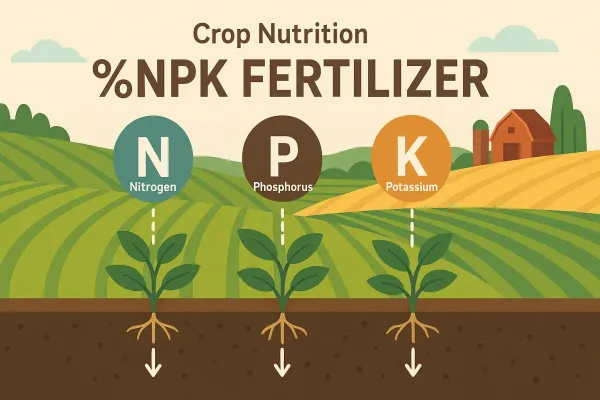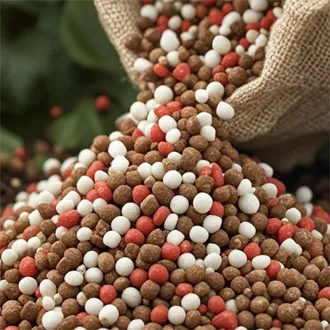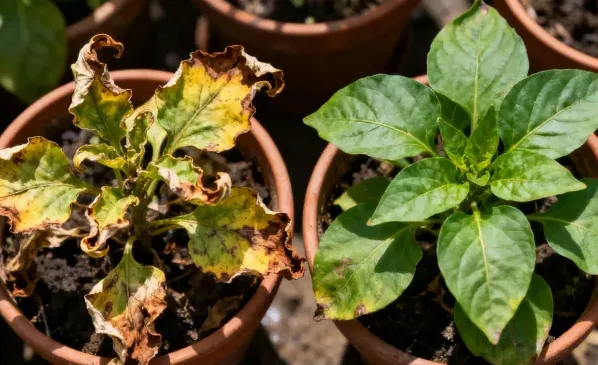Avoid your inquiry is delay response, please enter your WhatsApp/Skype along with the message, so we can contact you at the very first time.
We will reply you within 24 hours. If for urgent case, please add WhatsApp/WeChat:
Warning: Undefined variable $public in /www/wwwroot/lvfertilizer.com/wp-content/themes/hyhadmin/header.php on line 350
Warning: Trying to access array offset on value of type null in /www/wwwroot/lvfertilizer.com/wp-content/themes/hyhadmin/header.php on line 350
,. Or call
Warning: Undefined variable $public in /www/wwwroot/lvfertilizer.com/wp-content/themes/hyhadmin/header.php on line 350
Warning: Trying to access array offset on value of type null in /www/wwwroot/lvfertilizer.com/wp-content/themes/hyhadmin/header.php on line 350
directly.
Using npk fertilizer looks simple: one bag, three big numbers, and a promise of better plant growth. But if you use the wrong fertilizer on the wrong crop, you can waste money, harm roots, and even burn leaves instead of feeding your garden.
Most plants can use NPK fertilizer, but not all plants can use the same NPK formula, strength, or timing. Different plants and different stages of plant life require different NPK ratios. To get healthy plant growth, you must match the NPK to the soil test, crop type, and your goals.
On every good fertilizer bag you’ll see three numbers, sometimes written as an N-P-K or n-p-k ratio. NPK stands for nitrogen, phosphorus, and potassium – the three macronutrients plants need in the largest amounts for strong growth.
These three elements are often called the primary macronutrients and together they form the backbone of most modern plant fertilizer programs. Nitrogen drives green growth, phosphorus supports roots and blooms, and potassium builds strength and disease resistance so plants can handle heat, drought, and pests.
When you read that a product is called NPK fertilizer, it simply means the fertilizer contains these three macronutrients in a defined ratio. The NPK label is a quick way for gardeners, farmers, and agronomists to compare bags and choose the right mix of plant nutrients for their crops.
As a leading manufacturer and exporter of high-quality fertilizer products in China, we design blends where NPK is the base, and then we add additional nutrients such as calcium, magnesium, and selected micronutrient elements to match the plant needs of different markets and crops.

What Does NPK Fertilizer Stand For in Plant Nutrition
Here is the short answer: yes, almost all plants can use some form of NPK fertilizer – but no, not all plants should use the same one. Different plants have different needs, and every different plant in your field or garden reacts in its own way.
Think about a mixed garden:
So while npk fertilizer is a powerful way for plants to get essential nutrients, the stages require different balances. Seedlings, vegetative growth, flowering, and fruit production each require different NPK blends and application rates for best overall plant performance.
From our own experience supplying large farms, Government & NGO Agricultural Projects, and Fertilizer Brand Owners (OEM clients), the most successful programs never use “one bag for everything.” Instead, they build a simple plan around crop type, plant life stage, and soil tests.
Nitrogen is the key nutrient behind rich green growth. It is a component of chlorophyll, the pigment that makes plants green and allows photosynthesis to turn light into energy. Chlorophyll production and chlorophyll itself both depend on a steady supply of nitrogen.
Nitrogen is also part of many enzyme systems inside the plant. These enzymes control how plants use water and nutrients and how fast tissues grow. When there is much nitrogen, leaves become dark green with strong leafy and shoot growth. This is why high-nitrogen nitrogen fertilizers like urea are often used early in the season to push healthy plant growth and fast root growth in field crops.
Phosphorus supports a deep, strong root system and helps move energy around the plant. It plays a central role in ATP, the energy “currency” of plant cells, so it touches nearly every factor in plant development. When plants lacking phosphorus are tested, we often see poor roots, weak stems, and delayed bloom.
Sometimes labels still use the older spelling “phosphorous,” but they are talking about the same element. In our factory, we fine-tune phosphorus levels based on crop and soil so that nitrogen and phosphorus stay in balance and phosphorus is not wasted or lost.
Potassium is necessary for water balance and strong cell walls. It helps build strong cell walls, supports disease resistance, and keeps stomata working so plants can manage heat, drought, and salinity. Potassium also supports fruit production and quality in fruit-bearing crops like tomatoes, citrus, and grapes.
In nutrition programs, we often combine phosphorus and potassium to support roots, blooms and fruit, and stress tolerance at the same time. When all three elements are present in the right amounts, NPK helps plants grow with balance instead of forcing only top growth or only fruit.
Every NPK or n-p-k ratio is written as three numbers, for example 15-15-15 or 10-20-10. These three numbers indicate the percentage of nitrogen, phosphate (as P₂O₅), and potash (as K₂O) in the bag by weight. In other words, they show the percentage of each major nutrient in that product.
So if a fertilizer contains 10-10-10, it means:
The rest of the bag holds fillers, carriers, and sometimes additional nutrients such as calcium, magnesium, sulfur, and trace micronutrient elements.
| Plant group | Typical npk ratio (by analysis) | Main focus |
| Lawn grass | 20-5-10 or 24-6-12 | Strong nitrogen for turf |
| Leafy vegetables | 18-8-8 | High N for leafy crops |
| General garden use | 10-10-10 or 15-15-15 | Balanced feeding |
| Fruit-bearing plants | 8-16-24 or 10-20-20 | Extra P & K for fruit |
| Flowering plants | 10-30-20 | Bloom and root support |
Balanced NPK blends like 10-10-10 spread nutrients evenly, while high-N lawn fertilizers or high-K fruit formulas target specific plant needs. As a factory, we create custom OEM blends so international clients can offer the exact npk ratio their market prefers.

npk fertilizer
Simply put, plants require different nutrient mixes as they move through the season. Young seedlings focus on roots and basic structure; mature crops focus on yield and quality.
If plants lacking nitrogen or other nutrients are not corrected in time, their yields drop. Many crops start with a starter fertilizer, move to growth formulas, and then switch to bloom or fruit formulas. In our work with Commercial Farm Owners & Cooperatives, we design simple schedules that match each growing season and life stage, so NPK inputs match what plants get from soil and weather.
In short, while NPK works for almost everything, stages require different amounts. That is why we advise customers not to dump the same 15-15-15 on every field and every crop.
NPK blends are often described as synthetic fertilizers, especially when they are made from mineral salts. Organic fertilizers like compost and manure come from plant or animal materials and carry both NPK and carbon that feed soil biology. Both types can support overall soil health when used wisely.
Organic materials usually release nutrients slowly, while NPK products can deliver fast, exact doses. For example, some of our granular NPK products contain slow-release nitrogen forms and other prills that contain slow-release coatings. This slow-release design reduces leaching and gives a steadier feed over weeks instead of days.
High-analysis NPK uses sources like urea and other nitrogen fertilizers for nitrogen, superphosphate for phosphorus, and potassium salts for potassium. On top of that, we often add sulfur, magnesium, calcium, and micronutrient packages so one application covers both macro and micro nutrient needs.
For many large farms and Agricultural Distributors & Importers, the best strategy is to combine both: use NPK as a precise plant fertilizer and support long-term soil with cover crops, residue management, compost, and manure.
When there is nitrogen deficiency, older leaves often turn pale yellow first. Nitrogen-deficient plants usually show this on the lower leaves while new leaves stay greener. Over time, plants turn stunted, and yield drops sharply. In leafy crops and lawns, lack of nitrogen is the most common deficiency we see in the field.
With low phosphorus, plants may grow slowly and look dull or bluish-green. Roots stay small, so crops lodge easily in wind. In cold soils, even if enough P is present, it can be locked up and act like a hidden deficiency. That is why many starter NPK products focus on higher P for early plant growth and root system development.
Potassium deficiency often shows as brown or burnt edges on leaves, especially on sun-exposed side shoots. Because potassium is necessary for water regulation and strong cell walls, affected crops wilt faster and show poor stress tolerance. Fruiting crops with potassium deficiency can have poor fruit production and weak shelves.
In real projects, we use soil and tissue tests to confirm each deficiency before adjusting formulas. Our OEM partners appreciate that we can tweak their npk blends quickly once we see the field data.

How to Spot Nitrogen, Phosphorus and Potassium Deficiency in Plants?
Because different plants have different nutrient demands, choosing an NPK program is not guesswork – it is a simple matching game.
Leafy vegetables and forage crops
Flowering plants and ornamental flower beds
Fruit-bearing plants and orchards
When choosing an npk formula, think of it as choosing a tool: lawns and plants like turf want one thing, greenhouse tomatoes another. Many fruit-bearing plants and vines need less N late in the season to avoid excess soft growth and keep sugars high.
From our side as a manufacturer, we supply standard formulas but also design custom npk ratio products so each client can offer a branded plant fertilizer line that fits their region and marketing story.
Because we are a leading Chinese manufacturer and exporter, we see both sides: large-scale plantations with thousands of hectares and small garden markets where the local gardener just wants easy instructions.
In our factory:
For OEM clients, every bag can carry their brand while we handle the technical work: accurate blending, safe handling of raw materials, and consistent quality. That means you can focus on your distributors and farmers while we ensure the chemistry is right.
We also help design simple feeding charts so that plants require fewer emergency fixes in season. This type of support is critical for Government & NGO Agricultural Projects and large cooperatives who must protect both yield and environment.
Can I use one NPK fertilizer for every plant at home?
You can use a balanced NPK on most plants, but it is not ideal. Lawns, roses, houseplants, and vegetables require different amounts of nitrogen, phosphorus, and potassium. Whenever possible, choose formulas aimed at specific crops or at least adjust the dose.
What is the best way for plants to get nutrients from NPK fertilizers?
The best way for plants to get NPK is through correct timing, rate, and placement. Apply when roots are active, avoid very hot or very dry days, and always water after applying so water and nutrients move into the root zone.
Are synthetic NPK fertilizers safe for soil?
Modern NPK and other synthetic fertilizers are safe when used correctly. Problems appear when people use too much or apply at the wrong time. We always recommend soil tests, careful doses, and support from agronomists to protect overall soil health and nearby water.
What about manure and compost compared to bagged NPK?
Manure and compost add carbon and biology, improving structure and feeding soil organisms. NPK is more concentrated and exact. Together, they make a strong program: organics build the soil; NPK fine-tunes the exact nutrient supply.
Why do some fertilizers talk about NPK plus micronutrients?
While NPK covers the big three, plants also need iron, zinc, boron, and other micronutrient elements. Many of our products combine a strong NPK base with a balanced micro package to cover all plant nutrients in one application.
Is there a single NPK ratio that works for every crop?
No; there is no universal “magic” npk ratio. The right mix depends on soil tests, crop type, climate, and yield targets. That is why we work closely with Agricultural Distributors & Importers and OEM brands to design recipes that truly match their markets.